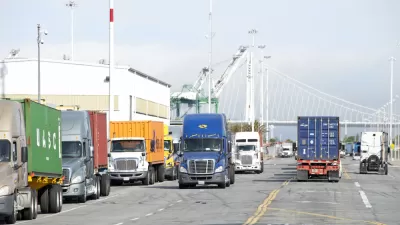Nonunion truckers at the Port of Oakland are on a work-stoppage over both work rules and compliance with a 2008 CARB diesel regulation requiring drayage trucks to be 2007 or newer. They want a year extension and more funding to assist in compliance.
Stephanie M. Lee writes about the stoppage that has obstructed deliveries to and from the fifth busiest container port in the United States. Regulations approved in December, 2008 by the Calif. Air Resources Board (CARB) were designed to tackle diesel powered trucks and buses, responsible for "one-third of the state's nitric-oxide emissions and 40 percent of the state's diesel particulate-matter emissions, which have been linked to more than 9,000 premature deaths annually", writes Lee.
Owners and operators of diesel trucks and buses have had to add soot filters, upgrade to newer engines or replace especially old vehicles. By Jan. 1, California will require all trucks serving its ports to have engines whose model year is 2007 or newer.
Lee writes that the "group of nonunion protesters calling itself the Port of Oakland Truckers Association is asking for a yearlong extension of the 2014 deadline. It also wants a monthly $50 "green emissions" fee to help offset the cost of upgrading the trucks." Three years ago, CARB had "rolled back diesel pollution limits".
Trucks servicing the port, as well as all trucks in California, have been eligible to receive funds set aside just for the purpose of meeting the truck and bus emission requirements (PDF). The protesting truckers are in fact part of a minority as "(m)ore than 70 percent of the roughly 5,900 trucks registered in Northern California are also already compliant" which helps to account why "diesel particulate matter from port trucks has plummeted 88 percent since 2005", according to the port.
The Port of Oakland, said it, along with the Bay Area Air Quality Management District (see August, 2013 news release), CARB (Truckstop) and the U.S. Environmental Protection Agency" have given $38 million to help truckers comply with deadlines.
More state funds will be flowing as a result of the passage of "AB 8, which authorizes an additional $2 billion over the next decade in incentives to reduce diesel emissions and support clean alternative fuels and technologies. The state Air Resources Board has estimated that the diesel-emission reduction laws would prevent about 3,500 premature deaths statewide", writes Lee. [Note: AB 8 was also described on Oct. 3 as one of "six new laws that made California more EV-friendly".]
Bonnie Holmes-Gen, the American Lung Association senior director for policy and advocacy in California, "said that while it's important to help truck owners comply with the deadline, their health, too, is at stake."
"The bottom line is we need to transition to cleaner fuels and equipment in order to reduce these tremendous health burdens on the area and in order to reach our air quality and greenhouse gas goals," she said. "We have to move forward and make the transition work."
FULL STORY: Oakland truckers strike to protest pollution rules

Study: Maui’s Plan to Convert Vacation Rentals to Long-Term Housing Could Cause Nearly $1 Billion Economic Loss
The plan would reduce visitor accommodation by 25,% resulting in 1,900 jobs lost.

Alabama: Trump Terminates Settlements for Black Communities Harmed By Raw Sewage
Trump deemed the landmark civil rights agreement “illegal DEI and environmental justice policy.”

North Texas Transit Leaders Tout Benefits of TOD for Growing Region
At a summit focused on transit-oriented development, policymakers discussed how North Texas’ expanded light rail system can serve as a tool for economic growth.

Paris Bike Boom Leads to Steep Drop in Air Pollution
The French city’s air quality has improved dramatically in the past 20 years, coinciding with a growth in cycling.

Why Housing Costs More to Build in California Than in Texas
Hard costs like labor and materials combined with ‘soft’ costs such as permitting make building in the San Francisco Bay Area almost three times as costly as in Texas cities.

San Diego County Sees a Rise in Urban Coyotes
San Diego County experiences a rise in urban coyotes, as sightings become prevalent throughout its urban neighbourhoods and surrounding areas.
Urban Design for Planners 1: Software Tools
This six-course series explores essential urban design concepts using open source software and equips planners with the tools they need to participate fully in the urban design process.
Planning for Universal Design
Learn the tools for implementing Universal Design in planning regulations.
Smith Gee Studio
Alamo Area Metropolitan Planning Organization
City of Santa Clarita
Institute for Housing and Urban Development Studies (IHS)
City of Grandview
Harvard GSD Executive Education
Toledo-Lucas County Plan Commissions
Salt Lake City
NYU Wagner Graduate School of Public Service



























